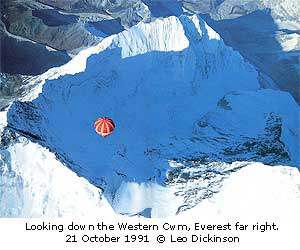

Balloon expeditions to Everest
1990
Three Japanese, Michio Kanda, Sabu Ichiyoshi and Etushi Saito took off in a hot air balloon on 9 May from Yeleb in Tibet, some 40 miles NE of Everest. They became becalmed and then crashed into the mountain at 18,500 ft nearly out of gas. Ichiyoshi broke his leg on impact and they were all lucky to escape the subsequent fire and gas explosion. They lost all their survival equipment in the fire but Kanda descended to base camp while the other two sheltered under their parachutes. They were finally rescued after 36 hours on the mountain.
1991
The British / Australian ‘Star Micronics” team launched two large hot air balloons at 16,000 ft with Chris Dewhirst / Leo Dickinson and Andy Elson / Eric Jones on board on 21 October from Gokyo some 15 miles to the West of Everest. Detailed meterological work resulted in an almost perfect flight route over the summit.
 The
actual flights however didn’t go entirely to plan; the two balloons got
separated at the very start and so an important photographic opportunity was
substantially lost. As the first
balloon crossed the summit at 34,000 ft and 60 MPH the second balloon had a
series of burner failures; Eric Jones recalled: “when the burners went out,
the mountain just kept growing and growing as we sank towards it” while
Andy Elson said later “as I slid down into the basket having lit the burners
for the third time, I looked at the altimeter and saw it reading somewhere
around 26,000 ft., By now we were well
past Nuptse and over the Western Cwm.
The big mass of Everest was getting bigger all the time, but I knew that
at some point it must stop getting bigger.
I looked at the mountain approaching and had the distinct feeling that
Eric was getting ready to leave.”
As they approached the South Col with all burners blazing, seven steel
flying wires separated from the balloon, in one corner there was just one wire
remaining. “As we cleared the
mountain I thought we were over the worst.
Just at that moment we hit turbulence.” said Jones, however the
balloon survived and they passed over the South Col with about 2,000 ft to
spare.
The
actual flights however didn’t go entirely to plan; the two balloons got
separated at the very start and so an important photographic opportunity was
substantially lost. As the first
balloon crossed the summit at 34,000 ft and 60 MPH the second balloon had a
series of burner failures; Eric Jones recalled: “when the burners went out,
the mountain just kept growing and growing as we sank towards it” while
Andy Elson said later “as I slid down into the basket having lit the burners
for the third time, I looked at the altimeter and saw it reading somewhere
around 26,000 ft., By now we were well
past Nuptse and over the Western Cwm.
The big mass of Everest was getting bigger all the time, but I knew that
at some point it must stop getting bigger.
I looked at the mountain approaching and had the distinct feeling that
Eric was getting ready to leave.”
As they approached the South Col with all burners blazing, seven steel
flying wires separated from the balloon, in one corner there was just one wire
remaining. “As we cleared the
mountain I thought we were over the worst.
Just at that moment we hit turbulence.” said Jones, however the
balloon survived and they passed over the South Col with about 2,000 ft to
spare.
The drama wasn’t completely over. The first balloon may have easily cleared the mountain but they had used up much more gas than planned and now only had enough remaining for one attempt at arresting their descent to land on the Tibetan plateau some 50 miles to the East of the mountain. They struck a Moraine ridge hard at 20 mph and swung across a valley. During the second bounce both pilots were ejected violently from the basket, Leo Dickinson had a narrow escape when a rope tangled around his foot and was dragged for some way through a rock field before he managed to slip out of his boot. The balloon carried on for some considerable distance before one of them managed to catch it up and deflate it. By contrast, Andy Elson landed his balloon a few miles away in nil wind with plenty of gas remaining.
2001
In mid-September  the
Celebrated British explorer David Hempleman-Adams was forced to abandon the
Cadbury Everest Challenge, a solo attempt to fly a hot-air balloon over Everest
from the Rongbuk monastery after the Chinese authorities withdrew his
permission to fly, probably as a result of the recent 9/11 attack in New York.
the
Celebrated British explorer David Hempleman-Adams was forced to abandon the
Cadbury Everest Challenge, a solo attempt to fly a hot-air balloon over Everest
from the Rongbuk monastery after the Chinese authorities withdrew his
permission to fly, probably as a result of the recent 9/11 attack in New York.











